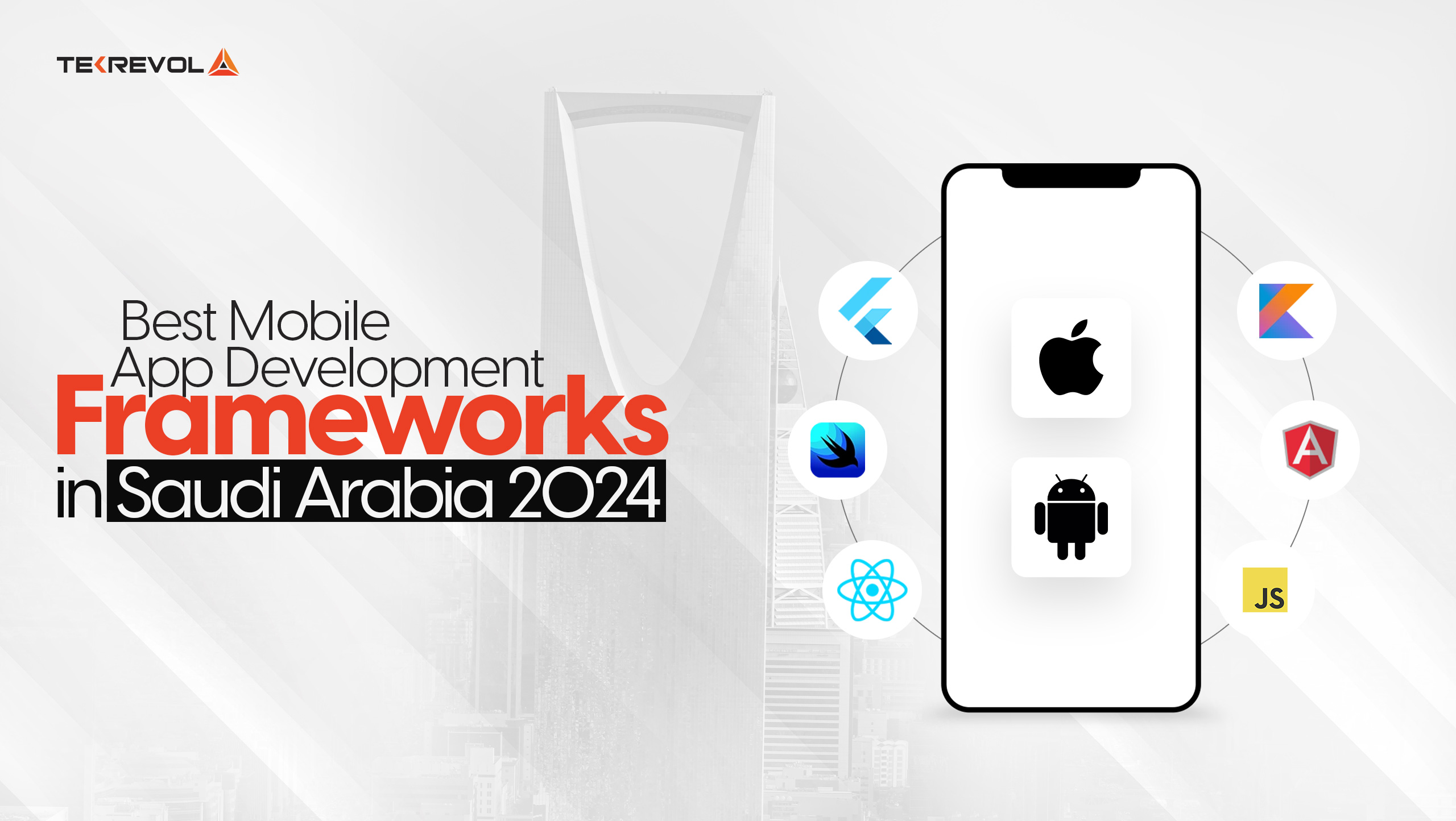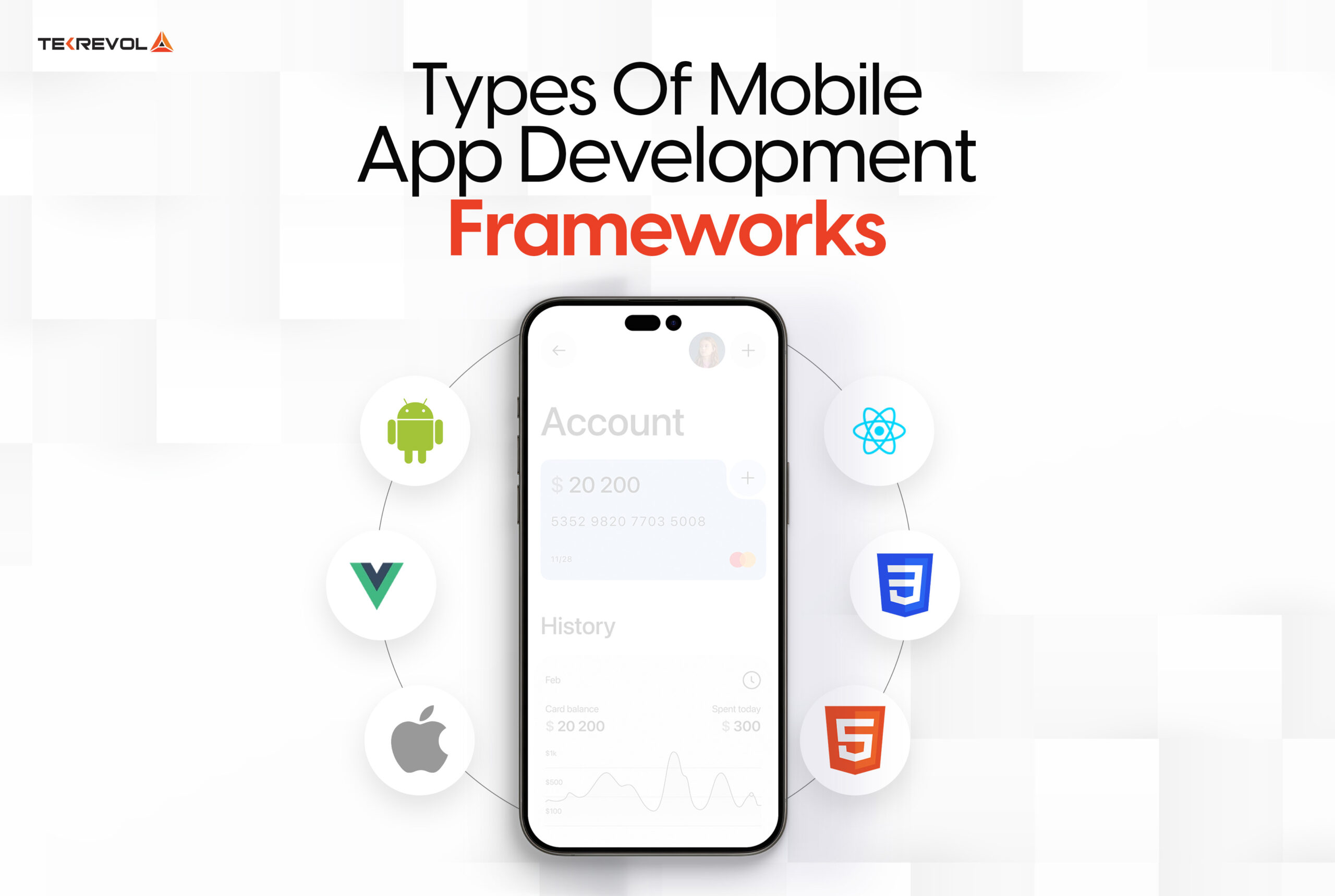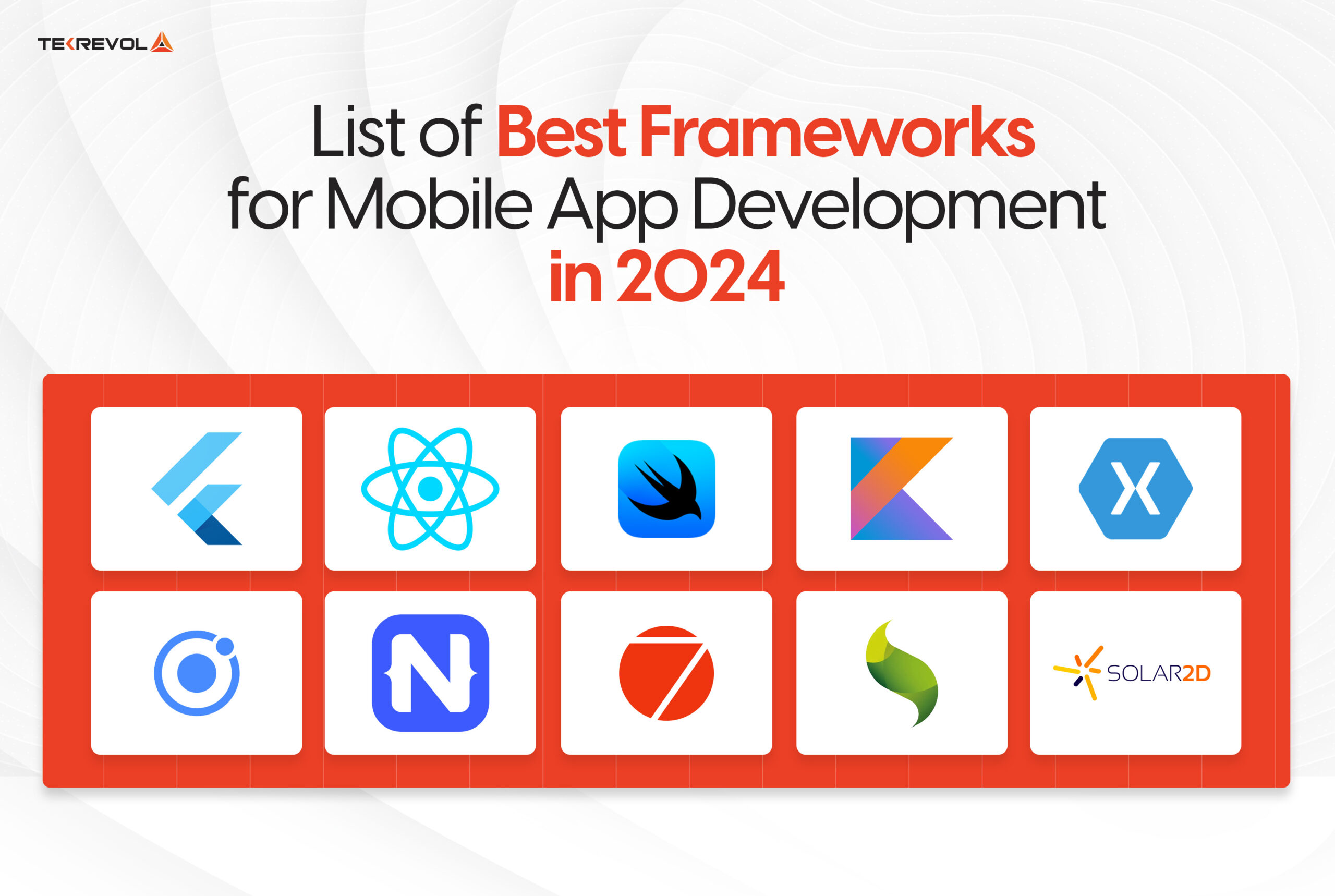Mobile App Development Frameworks in Saudi Arabia 2025
Notice: Undefined variable: aid in /var/www/html/test-wordpress/wordpress/wp-content/themes/tekrevol/single.php on line 366
Aqsa K. | April 16, 2025 -
- App Development KSA
- |
- KSA
- |

The mobile app development landscape is always developing and expanding, aided by innovative frameworks and tools to assist developers in their jobs, speed performance, and advance UX designs.
Thus, selecting the right mobile app development framework is crucial for developers and businesses aiming to create high-quality, scalable applications. Simply entering the mobile market is not enough to maintain a sustainable competitive advantage.
In 2025, the trends are now equal mix of cross-platform and native frameworks, allowing businesses to construct applications that give excellent user experiences across all devices.
This article will discuss in detail the best mobile development frameworks used by reputable mobile app development companies in Saudi Arabia, including their pros and cons.
What is a Mobile App Development Framework?
Mobile application development frameworks are essential platforms that provide the necessary infrastructures, libraries, and elements to create mobile applications. These frameworks ensure that the development process is easy, as one can design several applications, such as Android, IOS, and web-based, with less effort and time.
Types Of Mobile App Development Frameworks

Choosing the right app framework is therefore key to the way you want your app to perform in today’s fast-growing mobile environment. Here’s a breakdown of the primary types of mobile app frameworks available:
Native Frameworks:
Native frameworks are designed specifically for frameworks such as iOS and Android, and they provide good performance as well as access to the platforms’ capabilities. However, the disadvantage is that one must develop separate code for each interface, which can be complex and time-consuming.
Web Frameworks:
Also known as cross-platform frameworks, these allow programmers to write code for multiple operating systems. Web frameworks are more affordable because they leverage web technologies, and while they may not be as resourceful as app frameworks, the difference is not significant.
Hybrid Frameworks:
These frameworks combine native and web frameworks to deliver faster execution and portability across devices. They leverage web technologies for the user interface and connect with native functionality through plugins. While they enable quicker development cycles, there may be performance difficulties.
When implementing these frameworks, it’s better to collaborate with the best mobile app development company in Saudi Arabia that guarantees things like easy upgradeability, great performance, and complete access to the feature set.
List of Best Frameworks for Mobile App Development in 2025

Selecting a mobile application framework may shape the development process and touch upon performance, scalability, and user experience. Here’s a list of the top frameworks for mobile app development that are setting industry standards in 2025:
-
Flutter
Flutter is an open-source mobile development tool created by Google, which has recently attracted more and more attention because of its flexibility and productivity. It enables developers to create applications for mobile as well as for Web and desktop using a single set of code.
Among the key features, hot reload is remarkable for guiding teams to check the changes that have occurred in the application’s code without complete logout. The availability of several already set-up widgets and refined UI allows for seamless actions and a rich, app-like experience across all platforms.
Key Features
- Hot Reload for code change without having to restart the app.
- High level of UI elements and adjustable gadgets
- Multi-device compatibility (Android, iOS, web, desktop)
- Smooth animations and interactions for a fast and fluid run-time environment.
Pros:
Faster Development:
Hot reload and a single codebase enable developers to work quickly while spending little time on written code.
Beautiful UIs:
With the extensive widget library, developers are provided with unique designs that can be customized to their goals and preferences to create stunning user interfaces.
Cross-Platform Flexibility:
Create applications for a variety of target settings with few code modifications.
Significant Community Support:
It has significant backing from Google, and its developer support base is rapidly expanding, saying that it has all of the materials and upgrades.
Cons:
Large App Size:
Flutter apps take up more space on the user’s device than native apps because of the engine supported by Flutter.
Limited Native Libraries:
There are numerous plugins available in Flutter, but some unique platform functionalities may require more effort or the use of natives.
Platform-Specific Challenges:
Interacting with the platform can often be more challenging in hybrid application development versus in native development.
-
React Native
Developed and maintained by Meta previously known as Facebook, React Native is among the most reliable and utterly popular cross-platform frameworks. It allows developers to have one code as compared to having different versions for two different operating systems such as iOS and Android hence cutting short the developmental time considerably.
React Native is a popular choice among companies, particularly those in Saudi Arabia, for creating scalable, reasonably priced apps with excellent user experiences.
Key Features:
- Develop once and run on several systems.
- An abundance of support and resources.
- Native incorporation to enhance the app’s performance for the user.
Pros:
Faster Development:
Cuts down the time required for development since many areas of code can be used frequently.
Cost-Effective:
A single code base also brings down the development and maintenance costs significantly.
Native Performance:
Is close to native app performance and can access native APIs.
Cons:
Performance Limitations:
A little bit slower in comparison with fully native apps for performing complex functions.
Frequent Updates:
Due to the continuously evolving nature of React Native, applications developed on this framework may need frequent updates.
-
SwiftUI
SwiftUI, developed by Apple, is increasingly gaining prominence as one of the most effective methods for creating appealing and high-performance iOS applications. SwiftUI is praised for its declarative approach, which allows designers to develop beautiful UIs.
Due to its compatibility with Xcode, developers and designers can simply implement, preview, and test apps on a variety of devices, streamlining the app development process.
Key Features:
- Create a quicker and more natural UI.
- Give users the power to write code once and run on iOS, macOS, and watchOS.
- Compatible with Apple’s Swift language optimization.
Pros:
Optimized for Apple Devices:
SwiftUI is unifying across all Apple platforms to reuse up to 70 percent of the code.
Real-Time Previews:
Integration with Xcode offers Live Preview, which enables developers to work more efficiently.
Future-Proof:
Being the newest Apple framework, it’s actively updated and has full support from Apple.
Cons
Limited Backward Compatibility:
It is compatible with iOS 13 and above which reduces its compatibility with older devices.
Feature Limitations:
Still less refined and has fewer features than UIKit that could be potentially required for more comprehensive development.
-
Kotlin Multiplatform
Kotlin Multiplatform is increasingly gaining popularity as a framework for cross-compiling applications for several platforms, including iOS, web, and even desktop applications, despite its origins as an Android-exclusive framework.
It is a groundbreaking notion that enables developers to reuse a significant percentage of their code across multiple platforms while maintaining native-level speed and user interfaces. Kotlin Multiplatform significantly accelerates application development and reduces time-to-market by allowing for code reuse.
Key Features:
- The ability to write code that can be used by all platforms.
- Builds upon tools and environments that are already familiar to Android developers.
- Gives consumers a native app experience without sacrificing speed in the process.
Pros:
Code Reusability:
This avoids the need for repeated work, thus speeding up development time.
Native User Experience:
Delivering applications that retain the look and feel of native applications on each intended platform increases the satisfaction level of the end user.
Growing Community Support:
Powerful community resources, libraries, and frameworks accompany Kotlin as it becomes more and more popular.
Cons:
Learning Curve:
The Kotlin language is relatively new to developers who may find it difficult to get familiar with or learn it in a multiplatform environment.
Limited Resources:
The ecosystem around Kotlin Multiplatform is still emerging in comparison to more mature frameworks, which may result in fewer libraries and tools.
-
Xamarin
Xamarin, owned by Microsoft, is a sophisticated framework that enables developers to design applications in C# and deploy them on both Android and iOS, making it ideal for any business interested in the two key platforms.
Xamarin, which is known for its exceptional performance, is designed to operate seamlessly with Visual Studio and provide direct access to APIs. This makes it excellent for organizations that want to have robust app performance across several platforms without sacrificing native appearance and feel.
Key Features:
- Provides native-like speed and performance by leveraging the platform APIs.
- Compatible with Microsoft’s development tools as well as in debugging the constructed system.
Pros:
Code Sharing:
Substantial sharing of code across platforms thus minimizing the time and resources needed to develop applications.
Native Look & Feel:
Provides a fully natural feel on both iOS and Android platforms.
Comprehensive Toolset:
Combined with Microsoft services, Visual Studio and Xamarin provide a comprehensive development solution.
Cons:
App Size:
Developing Xamarin apps can lead to creating relatively large applications owing to the inclusion of extra DLLs.
Performance Overhead:
Although it is close to native, there can be some performance penalties compared to true native apps.
Steep Learning Curve:
Occasionally, when having to deal with specific platform interfaces, new developers of C# or Xamarin might find it difficult to work with the framework.
-
Ionic
One of the most well-liked frameworks for creating hybrid mobile apps is Ionic, which is ideal for any company planning to employ HTML, CSS, and JavaScript. Ionic is a framework designed to enable web developers to create apps quickly, regardless of the platform on which they will be utilized.
Ionic continues to be a preferred tool for businesses that are in search of a ‘quick fix’ solution when it comes to building cross-platform applications that emulate native applications across various operating systems.
Key Features:
- Provides a rich set of predefined UI constructs, which give apps a sleek native look and feel.
- Develops applications that are fully integrated with Android, iOS, and the web.
- Builds on Angular, a strong framework, to enhance effectiveness and improve the speed of development.
Pros:
Easy Transition for Web Developers:
Ionic also does not require a lot of learning because web developers can quickly adapt to it due to its tooling.
Cost-Effective:
It is a hybrid framework that cuts across the development cost due to the reuse of code in the different platforms.
Rich UI Library:
Re-usable UI components help in making the work faster and offer a better user interface.
Cons:
Performance Limitations:
Hybrid applications developed with Ionic are not as efficient as fully native applications for certain types of projects, particularly where the applications require a large intake of resources.
Limited Native Access:
However plugins are available to interact with native features but these are limited and are not as efficient as using native SDKs.
Dependency on Web Technologies:
It is overly dependent on web technologies meaning that often the user’s requirements of the mobile hardware are not met.
-
NativeScript
NativeScript is a powerful hybrid framework for developing applications for iOS and Android with all native performance. In contrast to many other hybrid frameworks, you can directly call native APIs using JavaScript in NativeScript, web technologies are not involved. This approach offers the assurance that any app built with NativeScript will have a native look on both the Android and iPhone environments for improved performance.
Key Features:
- NativeScript enables access to essential APIs using JavaScript without needing additional platform plugins.
- Developers familiar with Angular or Vue.js can seamlessly integrate them into NativeScript apps, enhancing flexibility and promoting code reuse.
- By directly invoking native APIs, NativeScript achieves exceptional performance comparable to fully native applications on both Android and iOS.
Pros:
Native-Like Experience:
NativeScript gives those near-native performance because it gives you direct access to native APIs and makes your apps smooth and responsive.
Framework Flexibility:
Compatibility with Angular and Vue.js makes it easy for developers to pick and manage this code while employing trending JavaScript frameworks.
Single Codebase:
Build applications for both Android and iOS platforms using the same set of codes thus cutting down on time and costs.
Cons:
Steeper Learning Curve:
Users who are not familiar with native APIs can have a harder time getting started compared to frameworks like Flutter or React Native.
Community Size:
However, when it comes to its community and a wide range of available plugins and libraries NativeScript is still considered to be smaller than other more popular frameworks like React Native or Flutter.
Plugin Limitations:
While the ability to utilize native APIs is a strong pro, there are still cases where some third-party plugins will be slightly behind in functionality and updates.
NativeScript is particularly appropriate for developers willing to create applications for various platforms while achieving the level of performance and functionality of native development, which is important for providing clients with quality platform-specific applications.
-
Framework7
Framework7 is a versatile and completely free open-source solution intended for creating various mobile, web, and desktop applications based on popular web technologies: HTML, CSS, and JS. It is particularly suitable for building hybrid native mobile applications and progressive web apps (PWAs) that offer high performance on both Android and iOS platforms.
Key Features:
- It is fairly easy to develop applications through the use of HTML, CSS, and JavaScript which lessens the difficulty level for developers.
- Pre-built controls provide the apps with the look and feel of native applications.
- Integrates well with both Android and iOS, perfect for hybrid and web applications.
Pros:
Ease to Use:
Easy for web developers to learn and integrate into mobile sites or apps without having to master the mobile environment.
Native-Like Experience:
Supports a native look on the mobile platforms due to the richness of the UI widgets.
Cost-Effective:
Shortens development time and expenses since they enable the reuse of coded messages in different platforms.
Strong PWA Support:
Best suited for creating PWA-focused applications to operate efficiently across the web frontend and backend platforms.
Cons:
Performance Limitations:
Applications developed with Framework7 are also not as efficient as fully native applications.
Limited Access to Native Features:
Not provide as much access to the specific features of a platform as a native framework provides.
Dependency on WebView:
As it is a hybrid framework, it uses WebView which has implications on the speed of the application.
-
Sencha Ext JS
Sencha Ext JS is a strong framework for developing web and mobile applications, especially those that involve data-intensive applications for the enterprise market. Ext JS by Sencha is used to develop feature-rich and sophisticated business applications that require a strong UI, and complex data handling and are built for scale.
Due to its effectiveness in handling numerous data structures and improving application performance, it is ideal for organizations with complex processes.
Key Features:
- Provides a wide choice of predefined widgets for creating complex interfaces with the least effort.
- Develop large-scale data-intensive business applications to support major business operations and processes.
- Allows for the creation of applications that work in both mobile and web platforms with similar interface layouts.
Pros:
Enterprise-Grade Capabilities:
Ideal for developing applications that are designed to be used on a larger scale and require larger repositories.
Rich UI Components:
Provides a vast selection of pre-built building blocks with managed features, saving development hours and improving UIs.
Data Handling:
Well equipped to handle large data sets and large high-powered data through effective tool sets for data management.
Cross-Platform Development:
Supports both applications for web and mobile devices, thus it can be used in a variety of cases.
Cons:
Steep Learning Curve:
As you have seen, Sencha Ext JS comes with a feature that could confuse developers who are new to the framework.
High Licensing Costs:
Most suitable for business-to-business applications because of its pricing model, which might be costly for smaller applications or innovative companies.
Heavy Framework:
This comes with the disadvantage of having more features affecting possible performance in cases where the application is not complex.
-
Corona SDK (Solar2D)
A versatile development platform made especially for creating 2D apps and games for mobile devices is Solar2D, formerly known as Corona SDK. Solar2D is a game engine that makes game development faster and more efficient by allowing developers to create apps for multiple platforms, including web, iOS, and Android.
Key Features:
- Provides a well-structured and easy-to-use development environment that ensures shortening of development time.
- Build once and run everywhere, from iOS, Android, and the web.
- Primarily designed for developing fast 2D applications and video games.
Pros:
Quick and Simple to Use:
Solar2D makes app development and prototyping simple.
Free & Open-Source:
This platform is very well-liked by independent developers and smaller projects because it has no costs associated with it.
Broad Platform Support:
Its cross-platform nature permits code to be reused repeatedly across different hardware and operating systems.
Active Community:
To address the problems, the community provides a wealth of information, plugins, and discussion boards.
Cons:
Limited to 2D:
Solar2D is well suited for building 2D games but has missing elements and is not optimized for 3D.
Smaller Ecosystem:
Solar2D may have a relatively small ecosystem compared to larger frameworks in terms of third-party plugins and libraries.
Less Suitable for Large Enterprises:
As great as it may be for indie games, it might not be as powerful for complex, enterprise-level apps with complex operations.
Why Framework Selection Is More Important Than Ever in Saudi Arabia’s Age of Digital Transformation
As Saudi Arabia quickly moves toward its Vision 2030 aspirations, mobile technology is emerging as the foundation for digital innovation in industries ranging from e-commerce and fintech to healthcare and education. Selecting the appropriate development framework is not a technical preference anymore but rather a strategic business choice.
Those companies that adopt scalable, high-performance frameworks do not only deliver greater user satisfaction but also take a competitive position in a mobile-first economy. In 2025, companies will have to realign their technology stack with market requirements, user habits, and regional digital infrastructure to remain relevant and future-proof.
Conclusion
Selecting the right mobile application development framework is crucial for developers and firms that have aspirations to succeed in the future years. If you are developing a cross-platform application for both Android and iOS a standalone iOS application, or even a web application, each framework brings out different advantages.
Partnering with a reputable mobile app development company can help you choose the right one as per your business needs and requirements, Understanding the newest frameworks will assist in guaranteeing your apps satisfy consumer needs as well as present stiff competition within the current market.
- Got an app idea?
- EWe’ll guide you in picking the right framework and manage the complete development process to ensure your app thrives!
Author : Aqsa K.
A dedicated content marketing enthusiast with a keen eye for storytelling, delves into the world of communications armed with a Bachelor's degree in Media. Her passion lies in crafting compelling narratives that resonate across varied audiences.
Let's Connect With Our Experts
Get valuable consultation form our professionals to discuss your project idea. We are here to help you with all of your queries.
Revolutionize Your Business
Collaborate with us and become a trendsetter through our innovative approach.
Get in Touch Now!
COPYRIGHT 2025 TEKREVOL ALL RIGHTS RESERVED.







